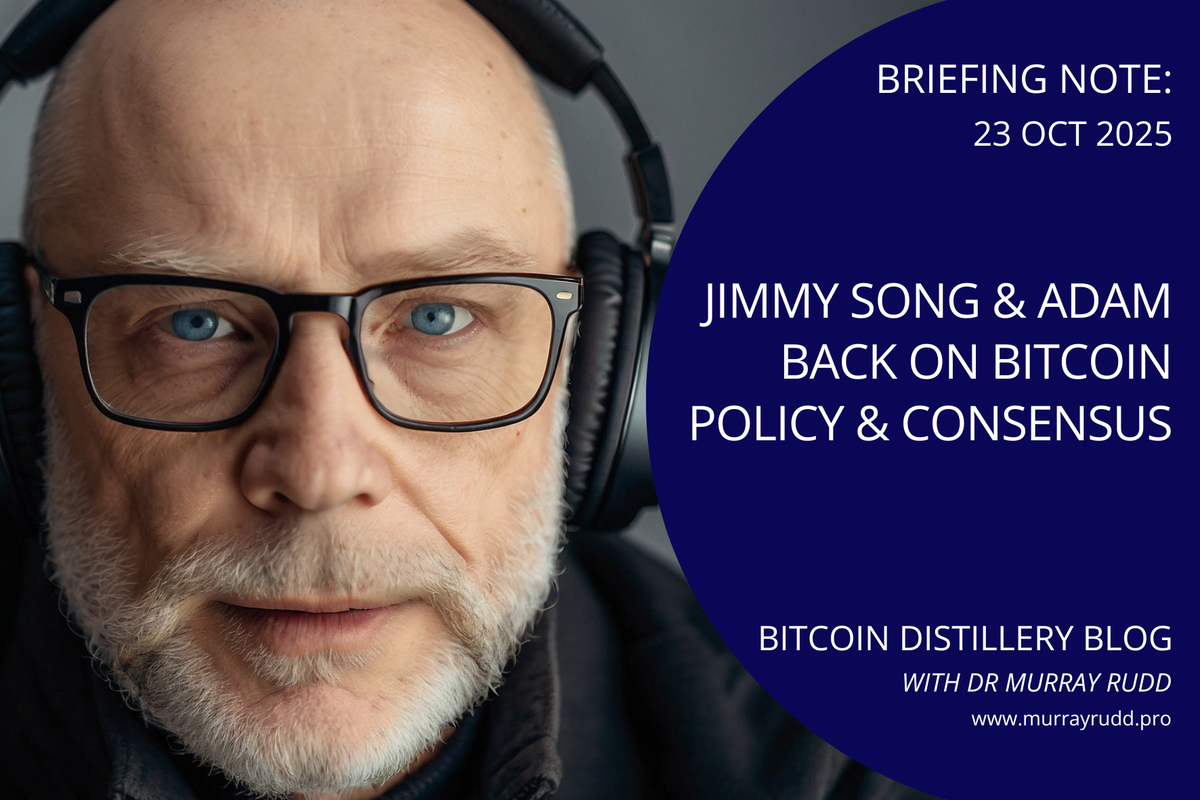Policy vs Consensus: Lessons from the Core v30 and Knots Debate
The October 16, 2025 episode of Tone Vays Podcast features Adam Back and Jimmy Song examining how Bitcoin Core v30 aligns relay policy with network behavior.

Briefing Notes contain: (1) a summary of podcast content; (2) potential information gaps; and (3) some speculative views on wider implications for Bitcoin. Most summaries are for Bitcoin-centered YouTube episodes but I also do some on AI and technological advance that spill over to affect Bitcoin.
Summary
The October 16, 2025 episode of Tone Vays Podcast features Adam Back and Jimmy Song examining how Bitcoin Core v30 aligns relay policy with network behavior. They separate policy from consensus and assess OP_RETURN changes, multiple OP_RETURN outputs, and sub-1 sat/vB propagation. The conversation maps risks and opportunities across relay reliability, miner incentives, fee dynamics, and client governance as Knots and Core diverge.
Take-Home Messages
- Policy vs Consensus: Core v30 targets relay policy, not consensus, keeping chain-split risk low while shaping mempools and incentives.
- Relay Robustness: Heterogeneous policies can degrade compact-block performance and raise orphan risk, pressuring miners’ networking choices.
- Fees Over Filters: Price signals may deter spam more reliably than filters that tolerant minorities can bypass via permissive relay.
- OP_RETURN Trade-offs: A higher default and multiple outputs could shift data off witnesses or simply expand non-financial payload surfaces.
- Governance and Diversity: Growing Knots adoption raises code-diff and coordination risk, making cross-client testing and documentation critical.
Overview
Adam Back and Jimmy Song frame Core v30 as a set of relay-policy updates that follow where users and miners already operate. They stress that policy governs mempool admission and propagation, while consensus decides block validity. This distinction lowers perceived fork risk and refocuses attention on network reliability and incentives.
They detail changes around OP_RETURN defaults and allowing multiple OP_RETURN outputs while acknowledging that sub-1 sat/vB transactions already move across the network. Song notes how tolerant-minority behavior and tools like permissive relays can route around stricter defaults. Back adds that aligning policy with observed practice can reduce friction but may widen channels for data embedding.
The pair examine second-order impacts on compact-block relay and orphan rates when mempools diverge due to policy differences. If public relay strains, miners may lean into private peering, shifting power toward larger actors. They question whether fee pressure is a cleaner deterrent to unwanted payloads than filters that can be sidestepped.
They connect Taproot-era inscriptions to present blockspace pressure and fee volatility. Both ask whether a larger OP_RETURN path meaningfully displaces witness-borne data or simply adds surface area. They close by flagging governance risk as Knots gains share, increasing exposure if client differences expand without coordinated testing.text
Stakeholder Perspectives
- Node Operators: Seek predictable mempools, strong compact-block relay, and minimal legal exposure from embedded content.
- Miners and Pools: Prefer high relay success and low orphan risk; may adopt private peering if public relay degrades.
- Wallets and App Developers: Need stable, documented policies to avoid UX breaks while evaluating legitimate multi-OP_RETURN use cases.
- Client Maintainers (Core/Knots): Balance neutrality, spam deterrence, and safety while minimizing risks from diverging code paths.
- Exchanges and Infra Providers: Require fee predictability and robust relay to prevent stuck deposits and reconciliation delays.
Implications and Future Outlook
If policy heterogeneity persists, empirical work on compact-block performance and orphan rates will guide whether fee-centric strategies outperform filtering. Clear metrics can prevent reactive swings between permissive and restrictive defaults. Miners’ networking choices will follow these reliability signals.
OP_RETURN adjustments may re-route some payloads away from witnesses, but net spam economics remain uncertain without measurement. Narrow, well-documented guardrails could protect usability without encouraging data hoarding. Coordinated defaults across major clients would lower accidental divergence risk.
Client diversity is healthy to a point; beyond it, uncoordinated differences raise governance and reliability costs. Shared test suites and transparent change rationales reduce accidental-fork exposure as Knots adoption grows. Evidence-driven iteration will matter more than rhetoric in the next release cycles.
Some Key Information Gaps
- How much does mempool divergence increase compact-block failures and orphan risk under v30-era policies? Quantifying this effect is essential for reliability planning and for deciding whether policy convergence is warranted.
- Which protocol changes (e.g., weak blocks or template gossip) best harden block relay amid heterogeneous policies? Comparing candidate designs can prioritize work that preserves decentralization while improving relay success.
- Under what conditions do miners adopt private peering that disadvantages smaller miners? Identifying thresholds informs mitigations that keep relay on open networks and sustain competition.
- What empirical evidence shows fees outperform relay filtering at deterring spam over multi-year cycles? Long-horizon data will validate strategy choices and reduce policy churn.
- How large are code diffs between Knots and Core across security-critical paths, and what is the fork risk? Mapping differences guides testing depth and sets safe bounds for client diversity.
Broader Implications for Bitcoin
Open Relay Health as Public Infrastructure
Bitcoin’s relay network behaves like public infrastructure whose reliability shapes miner economics and user trust. Evidence-based defaults and measurement norms can stabilize this layer without heavy-handed rules. Over the next 3–5 years, investment in shared testing and telemetry will likely pay higher dividends than contentious policy toggles.
Fee-Centric Neutrality Norms
If fees consistently outperform filters at deterring spam, neutrality norms will tilt toward pricing rather than content heuristics. That shift aligns incentives while preserving censorship resistance across jurisdictions. Expect wallets and services to optimize fee estimation and batching strategies as this norm hardens.
Managed Client Diversity
Multiple implementations can improve resilience yet raise coordination costs when diffs expand. Lightweight governance—shared test vectors, release notes with measurable goals, and pre-merge review rituals—can keep diversity from drifting into fragmentation. Over time, this discipline supports safer innovation without sacrificing interoperability.
Data Embedding and Legal Narratives
Policies that incidentally affect data embedding will intersect with legal and reputational narratives regardless of technical intent. Clear operator guidance and transparency about what relay policy does—and does not—imply can defuse overstated liability fears. The medium-term outcome is a more realistic public understanding of what node operators actually host or transmit.
Miner Networking Topologies
Relay reliability influences whether miners favor open peering or private links, with consequences for market structure. Protocol-level improvements that raise template propagation success can reduce incentives for closed networks. Over several release cycles, healthier topologies should sustain decentralization while improving block propagation safety.



Comments ()